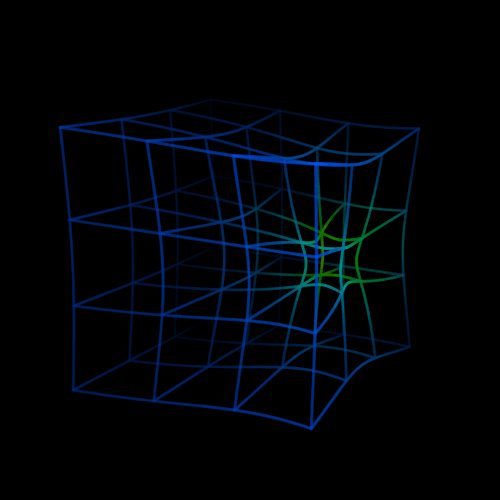Part 9: Thinking In Space-Time
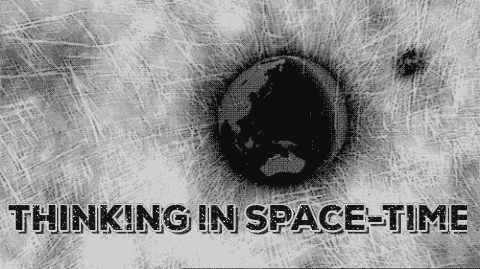
Impossible Science #1,#2,#3,#4,#5,#6,#7,#8,#9
Einstein’s special theory of relativity is best understood as a theory of space-time, the 4-dimensional world that forms the arena for all of physics.
In space-time, the universe does not “happen”; past, present, and future simply are parts of the system. Observers from within, divide space-time into space and time coordinates, and different observers do this in different ways. Two events that are simultaneous for one observer may not be simultaneous for another observer.
Albert Einstein’s theory of relativity was a revolution in physics, redrawing the boundary between the impossible and the possible. Many aspects of the theory may sound impossible, but all of them have been confirmed by experiment. To understand the theory, we must think of the universe as having 4 dimensions. 3 of space and 1 of time.

pixabay
Einstein proposed relativity to solve the mathematical inconsistency between Isaac Newton’s mechanics and James Clerk Maxwell’s electrical and magnetic field equations. Maxwell described light as a wave, a traveling disturbance in an electromagnetic field. Maxwell’s equations require an absolute speed of light, c, of roughly 300,000 kilometers per second. Newton’s mechanics predict that an observer in motion would observe a different light speed, and almost everyone, including Maxwell, thought this was correct.
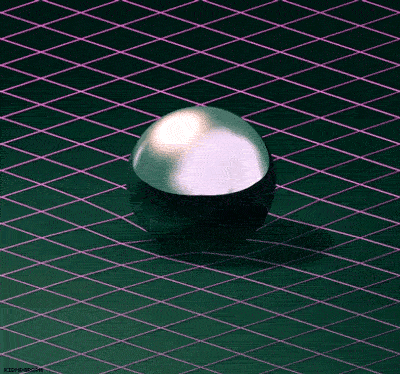
However, in the 1880s, Albert Michelson and Edward Morley performed a super-sensitive optical experiment and found that light speed was observed as an absolute, no matter how fast the observer moved.

Einstein’s radical solution to this problem was that Newton’s theory needed to be altered. Relativity states that space and time measurements are relative to an observer. The fundamental laws of physics are the same for all observers— that is, the speed of light remains constant. There is nothing special about light per-se; it is one of many things that moves at this fundamental speed.

wikipedia
Hermann Minkowski realized that Einstein’s theory was really about the relationship between space and time. Space is 3-dimensional: latitude, longitude, and altitude specify where an event takes place. To specify the “when” of an event, we need a fourth dimension, time. Everything that happens in the universe can be located by these 4 coordinates.
How can we visualize 4-dimensional geometry? We simplify. The standard space-time diagram is 2-dimensional, with space on the horizontal axis and time on the vertical axis.
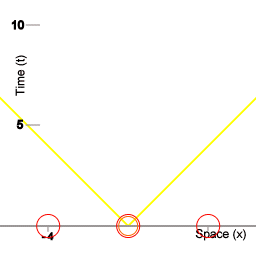
wiki
- Space is measured in meters;
- Time is converted to meters by multiplying it by c.
(A meter of time = 3 × 10−8 seconds.) - We call a point in space-time an event.
A moment in time consists of all points in space at a particular time; space-time is a stack of these moments, like stacking up all the frames of a film into a solid block.
The movement of a particle through space-time creates a world line, stretching from the past to future. If the particle at rest makes a straight up-down world line on a graph.
- A particle in uniform motion makes a straight diagonal world line.
- An accelerating particle makes a curved world line.
- A particle moving in a circle makes a helical world line.
- When particles collide, their world lines meet and bend.
- The movement of a larger object, such as a planet, creates a thicker world line, sometimes called a world tube.
Given 2 events A and B in space-time, we can write B A→ to mean that event B lies within the (future) light cone of A. If B is outside the light cone of A, we write B A→ / instead.
From the space-time point of view, events do not happen; they simply are. Picture effects moving outward from an event, like ripples from a stone thrown into a pond. In space-time, the circles are stacked up into an object called a light cone. The point of the cone is the event, and the effects move outward at a 45 degree angle (1 meter of space per 1 meter of time).
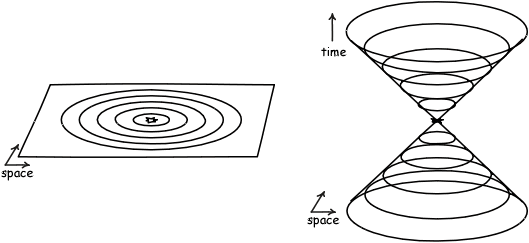
Source www.pitt.edu
When an observer witnesses an event, we say the observer’s world line intersects the light cone. If you extend the point of a light cone into the past, you include all events from which light reaches the point.
Einstein came to agree with Minkowski’s interpretation of relativity, calling the passage of time an illusion. Physics needs an “eternal” point of view, outside time.
What about this business of different observers—the relativity in relativity? Consider Alice, at rest, and Bob, moving to the right.
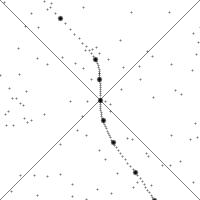
wikipedia
From Alice’s perspective, her world line is vertical, and Bob’s is tilted to the right. From Bob’s perspective, his is vertical and hers is tilted to the left. Their diagrams look a little different, but they represent the same space-time. Different observers assign different space and time coordinates to events. Events that are simultaneous for one observer may not be so for another. This resolves many seeming paradoxes of relativity.
Question for comments:
The Sun is so far away from Earth that it takes about 8 minutes for light to travel from one to the other. Explain why discussing what is happening right now on the Sun is in fact slightly ambiguous when used by an someone from Earth.
FOLLOW @pjheinz
Impossible Science
#1 - THREE TYPES OF IMPOSSIBLE
#2 - ALMOST IMPOSSIBLE
#3 - ABSOLUTE ZERO IMPOSSIBLE
#4 - IMPOSSIBLE PERPETUAL MOTION
#5 - CHAOS MAKES PREDICTING THE FUTURE IMPOSSIBLE
#6 - IMPOSSIBLE TIME TRAVEL
#7 - MAXWELL'S IMPOSSIBLE DEMON
#8 - GHOST PARTICLES AND THE SUN
#9 - THINKING IN SPACE-TIME

